Written by Sig Silber
HEADLINES (Updated 5:04 PM EDT) –
– Flooding remains likely for portions of the Mid-South as heavy rain continues to fall across areas where very heavy amounts have already occurred
– Scattered severe storms are likely Thursday afternoon and evening across the northern Plains
– Elevated to Critical Fire Weather conditions are in place across much of the Interior West

This article provides continuous updates for a variety of Weather and Weather-Related Threats as well as a general weather forecast. These are “Live” maps that continually update. Please pay attention to the Mesoscale Events maps — Mesoscale Events are potentially life-threatening situations.
Please share this article – Go to the very top of the page, right-hand side for social media buttons. Also, feel free to send this email to anyone you feel will benefit from it.
For those interested in longer-term forecasts, we just published the new NOAA Seasonal Outlook and it can be accessed here.
Readers can scan through this article or jump to where they want to go via the links to the right. To get back to the Directory, hit the back arrow at the top of the URL bar on your screen. But in many cases, one of my Editors has graciously inserted a Return to Directory link to click so that is even easier. This is so high tech that I hardly believe it. |
|
CONUS Focal Points

Short Range Focal Points
Short Range Forecast Discussion NWS Weather Prediction Center College Park MD
311 PM EDT Wed Jun 09 2021
Valid 00Z Thu Jun 10 2021 – 00Z Sat Jun 12 2021
…Flooding remains likely for portions of the Mid-South as heavy rain continues to fall across areas where very heavy amounts have already occurred…
…Scattered severe storms are likely Thursday afternoon and evening across the northern Plains…
…Elevated to Critical Fire Weather conditions are in place across much of the Interior West…
A slow-moving area of low pressure will continue to produce periods of very heavy rainfall across portions of the Mid South Wednesday night into Thursday. These heavy rains, in addition to the near-historic rains that have already occurred across portions of the region, will likely worsen the already dangerous flooding conditions occurring across portions of southern Arkansas and northern Mississippi. Heavy rain is also a concern farther to the east across much of the Tennessee and lower Ohio valleys, into the Appalachians and Mid Atlantic region, as plenty of moisture spreads across the region.
As noted, this system will be slow to move move east. As the threat for locally heavy rains continues across portions of the Tennessee and Ohio valleys on Thursday, the threat is expected to increase across the Mid Atlantic beginning Thursday and continuing into Friday. A cold front, sinking south into the region, is forecast to increase the potential for organized heavy rains, raising the threat for localized flash-flooding concerns across the region.
Meanwhile, the ongoing heatwave across the Northeast will begin to subside. Following one more day of well-above normal temperatures on Wednesday, temperatures are forecast to drop off by several degrees on Thursday, followed by an additional decrease on Friday as the previously noted front drops south through the Northeast into the Mid Atlantic.
In the West, widely scattered thunderstorms are forecast to develop late this afternoon and evening from the northern Rockies into central Montana. Some of these storms are expected to become severe — producing damaging winds and large hail.
Then on Thursday, scattered severe storms are likely during the afternoon and evening across portion of the northern Plains. A strong area of low pressure is expected to intensify east of the northern Rockies. This system is forecast to help support the development of severe storms capable of producing very large hail, damaging winds, and tornadoes from central Montana and eastern Wyoming to the Dakotas and Nebraska.
Gusty winds will accompany this system’s trailing cold front as it moves across the West over the next couple days. With no precipitation expected, Red Flag Warnings for critical fire weather conditions are in effect today from the central and southern Sierra Nevada to western Colorado. On Thursday, critical fire weather conditions are expected from northern Arizona northeastward through central Wyoming.
We try to keep this up to date but if is not you can find the updated version here.
When you click on this image it takes you to the SPC Fire Warning Page and you get a set of maps for Days 1, 2, 3 – 8, etc. You can then click on those for more detailed information. The map is a bit blurry as I tried to make it a bit larger than the map provided by NOAA but should be able to see where the current wildfire risks are. But if you click on this map, you will get to see three maps that show the risk for different time periods.
Thunderstorm Risk
This should play out something like shown in this 60 Hour Forecast Animation
Here is a national animation of weather fronts and precipitation forecasts with four 6-hour projections of the conditions that will apply covering the next 24 hours and a second day of two 12-hour projections the second of which is the forecast for 48 hours out and to the extent it applies for 12 hours, this animation is intended to provide coverage out to 60 hours. Beyond 60 hours, additional maps are available at links provided below. The explanation for the coding used in these maps, i.e. the full legend, can be found here although it includes some symbols that are no longer shown in the graphic because they are implemented by color-coding.

The two maps below break it down by day and may be easier to read.
Now, the Day One and Two CONUS Forecasts: These Maps Update Daily.
Day One CONUS Forecast | Day Two CONUS Forecast |
These graphics update and can be clicked on to enlarge. You can see where the weather will be | |
 | |
During the winter much of our weather originates in the Pacific. That is why we pay attention to the near-term history of storms arriving.
Temperature
A version that shows a 40 hour animation and some other views can be found here

– Return to Directory
Day 3 – 7 Hazards
Valid Saturday June 12 2021 – Wednesday June 16 2021
Hazards:– Flooding possible across portions of the Tennessee Valley.
– Flooding occurring or imminent across portions of the Lower Mississippi Valley and the Southern Plains.
– Excessive heat across portions of the Central Great Basin, California, and the Southwest, Sun-Wed, Jun 13-Jun 16.
– Excessive heat across portions of the Northern Plains and the Northern Rockies, Mon-Tue, Jun 14-Jun 15.
– Much above normal temperatures across portions of the Central Plains, the Central Rockies, the Central Great Basin, the Northern Plains, the Northern Rockies, the Southern Rockies, the Northern Great Basin, the Upper Mississippi Valley, and the Southwest, Sun-Wed, Jun 13-Jun 16.
– Much above normal temperatures across portions of the Northern Rockies and the Northern Great Basin, Sun-Tue, Jun 13-Jun 15.
Detailed Summary:
The medium range forecast period (Saturday, June 12 to Wednesday, June 16) will feature a building upper-level ridge over the Rockies, High Plains, and Southwest, with upper-level troughs expected over the East and Pacific Northwest. As a result, this weather pattern is forecast to focus much of the precipitation along the East Coast, Southeast, and Gulf Coast. However, outside of local impacts from isolated downpours, no widespread heavy rain is expected during this time frame. Temperatures are expected to remain around average to slightly below average along the East Coast, Southeast, and Deep South as well.
The main weather story across the Lower 48 during the medium range period will be associated with excessive heat and much above average temperatures throughout the West and north-central United States.
By this weekend, above average temperatures will begin to build across the Intermountain West, northern/central Rockies, and northern Plains. The sizzling heat will settle over this region due to an anomalously strong upper-level ridge/high pressure centered near the Four Corners region. There is high confidence within the global forecast guidance regarding this feature and associated weather pattern. The center of the highest temperature anomalies (15 to 20 degrees above average) are currently forecast over the northern Rockies and northern High Plains on Monday and Tuesday of next week. Widespread temperatures in the 90s are expected, with triple digits possible over central and eastern Montana. An excessive heat area was added to the hazards chart today to highlight the potential for temperatures to reach dangerously high levels throughout parts of Montana and northern Wyoming. This area of extreme heat may shift eastward and into the Dakotas and Minnesota by Wednesday, but large uncertainty exists here by the middle of next week regarding the magnitude of the above average temperatures.
The Intermountain West will also see scorching heat beginning on Sunday and lingering through next week. Places such as Salt Lake City, Utah could experience multiple days with high temperatures close to 100 degrees. Parts of the northern Great Basin should see relief from the summer heat by Wednesday as a Pacific cold front sweeps through.
Meanwhile, the Desert Southwest will also see its fair share of extreme heat, which will undoubtedly increase the already exceptional drought concerns over the region. With several consecutive days with high temperatures between 110 and 120 degrees possible by Sunday, residents are urged to plan on spending plenty of time indoors/out of the heat. High temperatures will possibly soar higher than 120 degrees throughout the typical desert valleys in the Southwest on Tuesday and Wednesday. Several daily high temperature records are forecast on Tuesday from southwest California and Arizona to Montana.
For Alaska, a potent low pressure system over the Bering Sea may bring gusty winds to the Aleutian islands and heavy rain to southwest portions of the state along the Gulf of Alaska late this weekend into early next week. However, both of these potential hazards appear to remain below threshold.
(This is updated only during the week) Note the first list is weather highlights, this list is hazards. Not sure there is that much of a difference but they come from two different parts of NOAA. The Day 3 – 7 Hazards List does not update on weekends. But it is still useful as it remains valid for the period of time it covers. Of course, all forecasts are subject to change. Later we show a map of the hazards. Perhaps we should show them together. |
Click here for the latest complete Day 3 -7 Hazards forecast which updates only on weekdays. It includes the full discussion which I do not update in this article but only present the highlights.
– Return to Directory
Ski Snow Reports
We will resume snow coverage in the Fall
– Return to Directory
Drought Coverage
We include drought information in this section.


More information can be found here.
June Drought Outlook.

Seasonal Outlook Issued May 20, 2021
Here is the short version of the discussion that was released with the new forecast.
Latest Seasonal Assessment – Drought improved across parts of Texas, northeastern Colorado, central Wyoming and the Northeast in the past month due to heavy rainfall, while drought developed or intensified in many parts of California, the Pacific Northwest, Northern Intermountain West, Northern Rockies, and the Carolinas due to increasing precipitation deficits. Drought persistence or development is favored for most of the West and High Plains, based on elevated probabilities of below normal precipitation and above normal temperatures for June-July-August. Drought removal or improvement is expected across east-central Texas along with most of Oklahoma due to heavy recent rainfall and additional heavy rainfall forecast for the rest of May.Lack of a rainfall signal from monthly and seasonal precipitation outlooks supports drought persistence across the Midwest. The Great Plains and Corn Belt will be closely monitored in the monthly drought outlooks through the summer. The wet monthly and seasonal outlooks along with the onset of the convective season strongly support removal across the small drought areas in southern Florida. The persistence forecast for the Northeast is based on a weak rainfall signal and likelihood of above normal temperatures during June-July-August along with a favorable time for soil moisture discharge.
Alaska is forecast to remain drought-free through the end of August. Drought is favored to persist across Puerto Rico during the next few months. Drought development and persistence is forecast across the leeward sides of the Hawaiian Islands.
– Return to Directory
Tropical Events
I am replacing the large with three small maps but you can click on them to get larger versions. Even though they are small maps you should be able to tell if there is activity and If I see activity I will make the map where there is activity full size and when available add other related maps. Sorry for any confusion but the NHC maps do not update during the Winter except if there is activity. We leave them in simply because if there is a storm NOAA will start to update the relevant map even though it is not normally updated during the off season. The maps are a bit small but if you click the map you can see the date and time when it was updated.
| the Central Pacific. | the Eastern Pacific | the Atlantic and the Gulf of Mexico |
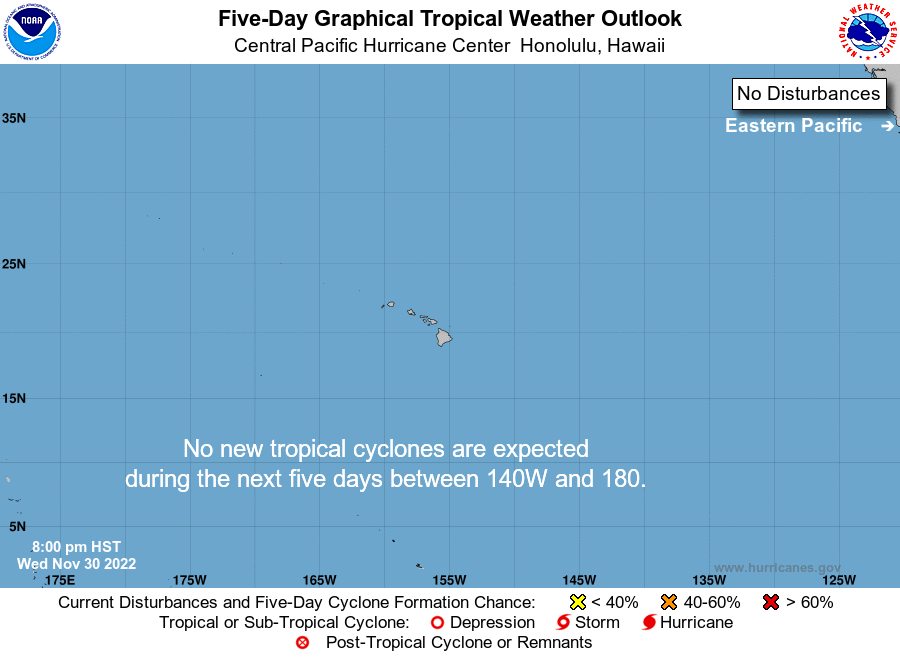 | 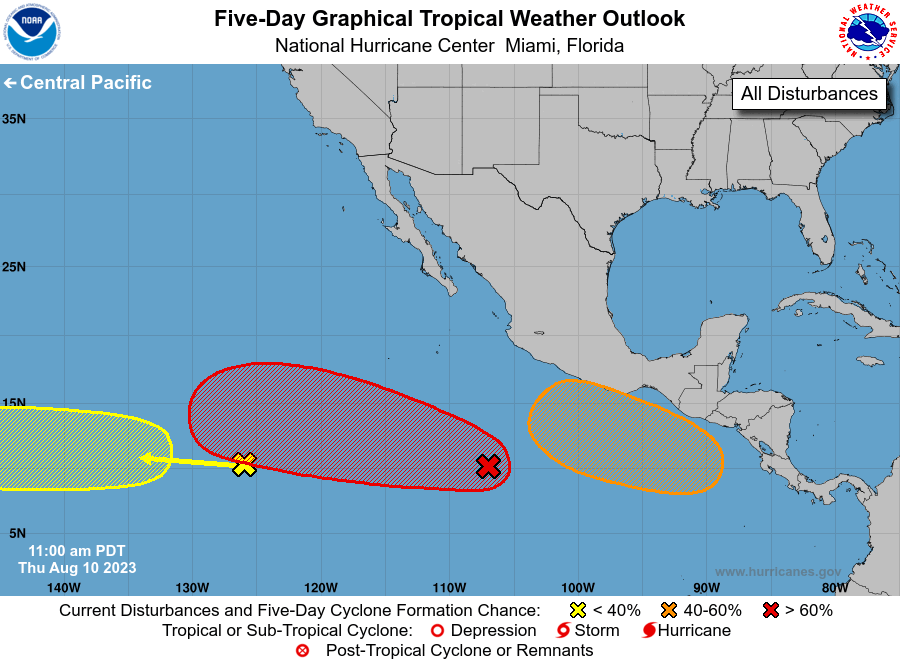 |  |
Atlantic and Gulf of Mexico
NA
The Eastern Pacific

The Central Pacific
NA
Updates on individual named storms can be obtained here.
And the Western Pacific

Weekly Tropical Forecast

– Return to Directory
Intermediate-Term Weather Forecast
And shifting to the Alaska and CONUS Intermediate-Term Weather Forecast showing from left to right, Days 1- 5, 6 – 10, 8 – 14 and Weeks 3 – 4 You can click on these maps to have them enlarge, there are larger versions in the Addendum (More Weather the link is shown at the end of this section, and there are larger versions of these maps in the Addendum. Also, the discussions that go with these forecast maps can be found here (first two weeks) and here (Weeks 3 and 4).
First Temperature
And then Precipitation
For those interested in more detail, there are additional weather maps and information in the MORE WEATHER Addendum. The link to the Addendum is here. |
– Return to Directory
Mesoscale Events
The following map shows where mesoscale events are occurring or forecast. If you do not see any areas highlight on this map than there are no mesoscale events taking place or forecast. A mesoscale event is a very serious situation for a very small area and detailed information is provided for these events when they occur or are forecast. If a mesoscale event is shown, click on the map and more detail on the event will be shown.
Two different parts of the NWS issue this map and they are not always in agreement although they are pretty close. They (Norman Oklahoma and College Park Maryland) issue the alerts when they realize the need, so it is best to look on both maps and click one or both if you see areas highlighted.
This next map showing where “Headlines” have been issued for convection (and an animation of the recent movement of storms) should update and you should be able to click on to get additional details but if it does not update when you click on it, click here.
There is a slight difference between convection and thunderstorms. The below map shows where “Headlines” have been issued for Thunderstorms. You should be able to click on the map to get additional details but if it does not update, you can click here.
The map below shows the current wildfire risk which becomes more significant as we move into Summer. When you click on this image it takes you to the SPC Fire Warning Page and you get a set of maps for Days 1, 2, 3 – 8, etc. You can then click on those for more detailed information. The map is a bit blurry as I tried to make it a bit larger than the map provided by NOAA but should be able to see where the current wildfire risks are. But if you click on this map, you will get to see three maps that show the risk for different time periods.
– Return to Directory
Now the Day 3 – 7 Hazards Outlook Maps

The orange and red outlined areas are what is most concerning of the forecasted Day 3 – 7 Hazards. This graphic does not update during the weekend. There is a discussion that goes with this graphic and you can access that discussion here.
The following is provided to help the reader relate the maps to how NWS will describe an area of the U.S.

– Return to Directory
Now to our More Detailed Weather Report
This graphic is about Atmospheric Rivers i.e. thick concentrated movements of water moisture. More explanation on Atmospheric Rivers can be found by clicking here or if you want more theoretical information by clicking here. The idea is that we have now concluded that moisture often moves via narrow but deep channels in the atmosphere (especially when the source of the moisture is over water) rather than being very spread out. This raises the potential for extreme precipitation events.
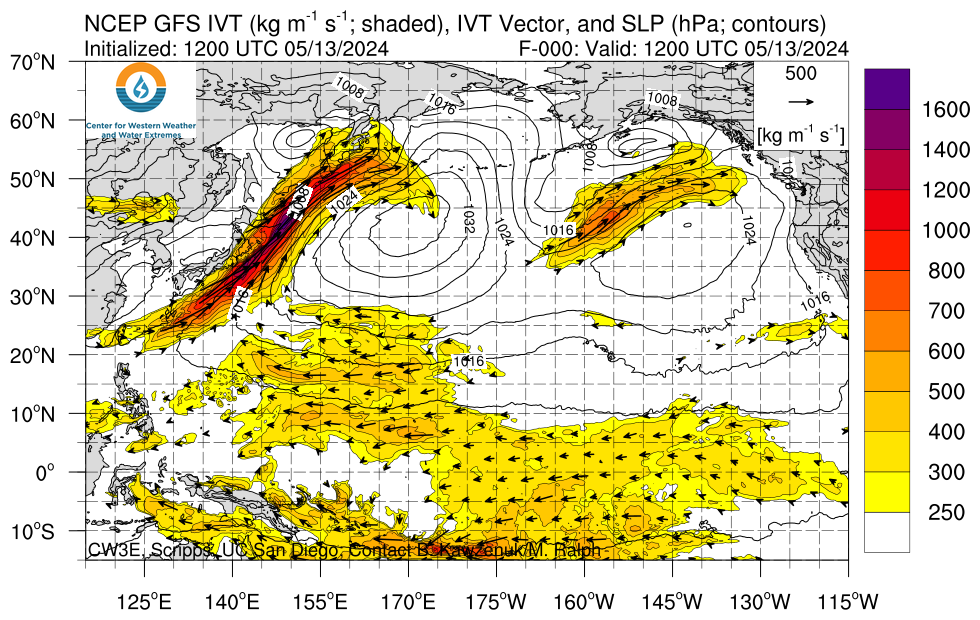
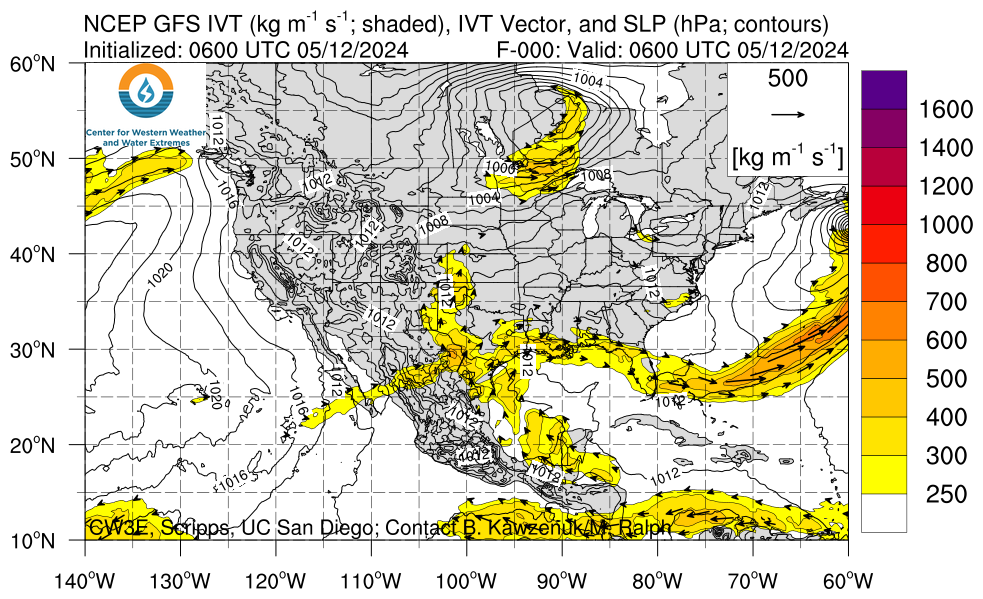
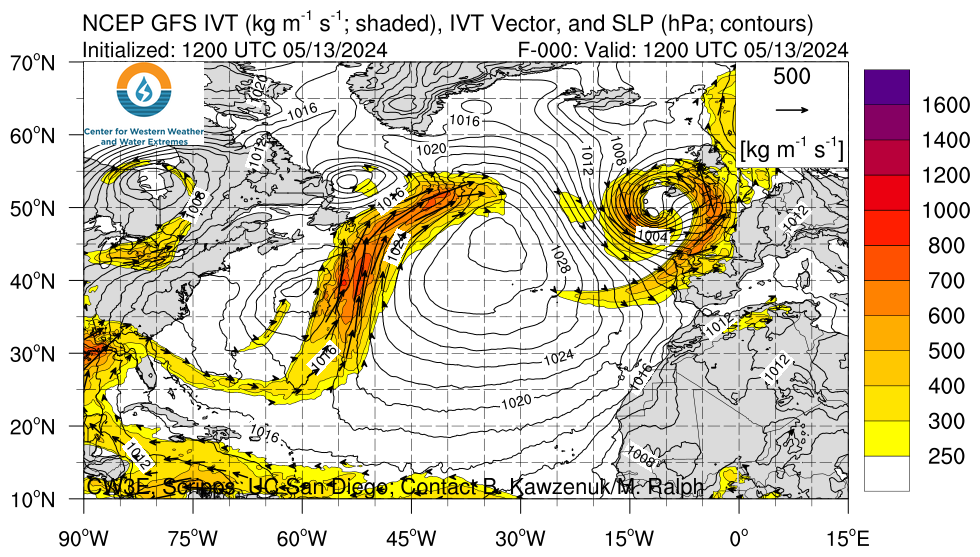
500 MB Mid-Atmosphere View
The map below is the mid-atmosphere 3-Day chart rather than the surface highs and lows and weather features. In some cases, it provides a clearer less confusing picture as it shows only the major pressure gradients. This graphic auto-updates so when you look at it you will see NOAA’s latest thinking. The speed at which these troughs and ridges travel across the nation will determine the timing of weather impacts. This graphic auto-updates I think every six hours and it changes a lot. Thinking about clockwise movements around High-Pressure Systems and counterclockwise movements around Low-Pressure Systems provides a lot of information.


| Day 3 Above, 6 Below | Day 4 Above,7 Below | Day 5 Above. |
 |  |  |
 |  |  |
Here are the precipitation forecasts. First the cumulative for Days 1 – 3

Then cumulative for Days 1 – 5
Then cumulative for Days 1 – 7

Looking ahead to next week.

– Return to Directory
Additional Tools to Obtain Watches and Warnings
| Current watches, warnings, and advisories issued by the agencies of the National Weather Service. Hazards should show up in the various maps but the below links will take you to all outstanding watches and warnings in each category which may include some categories not covered in the various maps or difficult to find. So if there is a category of interest, click on the appropriate link below. |
|
Below you will see a number of different maps that are updated in real-time, making this a “live” report. If a part of one or more of the maps shows an area that is highlighted, you can click on it and get the full current report. By having the reader click on these active situations rather than having GEI do so, you will not miss any events in which you might have an interest and which we had not noticed and the page will not get cluttered with warnings, etc that have since expired.
Our focus here is events that are likely to last in the range of six hours but there can be longer or shorter events that are addressed by the Storm Prediction Center which is the main source of the information in this article. Long-term major events like a Hurricane are more likely to be in a separate article. But that may not always be the case. Since in general, all the links on this page transfer you into the NOAA system, in order to get back into this article you need to either close the tab to which you were transferred or click back on the tab that has this article.
| Live Warning Maps which If Severe Weather is Shown can be Clicked on to get more detail about these events. If there is a current warning shown on the map, click on the map for additional information related to the event. | These maps are updated as risks are identified. |
| This is the current graphic showing any mesoscale discussions (MD’s) which are in effect over the contiguous United States. Please read the description of the purpose of our MD’s for further information. Details on all valid MD’s may be found on our Current Mesoscale Discussions page. |  |
| Convective Outlooks | |
|---|---|
| This is today’s forecast for organized severe thunderstorms over the contiguous United States. Please read the description of the risk categories for further information. You may find the latest Day 1 Outlook available as well as all Outlooks issued today online. | Today’s Outlook |
 | |
| This is tomorrow’s forecast for organized severe thunderstorms over the contiguous United States. Please read the description of the risk categories for further information. The latest Day 2 Outlook is available as well as all Outlooks that have been issued today. | Tomorrow’s Outlook |
 | |
| This is the day after tomorrow’s (day 3) forecast for organized severe thunderstorms over the contiguous United States. Please read the description of the risk categories for further information. The latest Day 3 Outlook is available as well as all Outlooks that have been issued today. | Day 3 Outlook |
 | |
| This is the day 4-8 forecast for organized severe thunderstorms over the contiguous United States. The latest Day 4-8 Outlook is available as well as all Outlooks that have been issued today. Note: A severe weather area depicted in the Day 4-8 period indicates a 30% or higher probability for severe thunderstorms (e.g. a 30% chance that a severe thunderstorm will occur within 25 miles of any point). | Day 4-8 Outlook |
 | |
| The Thunderstorm Outlooks depict the probability of thunderstorms across the contiguous United States in 4 or 8 hour time periods. The probabilistic forecast directly expresses the best estimate of a thunderstorm occurring within 12 miles of a point. The three probabilistic forecast thresholds are 10, 40, and 70 percent. | Thunderstorm Outlook |
 | |
| Fire Weather Outlooks | |
| This is today’s forecast for organized wildfires over the contiguous United States. Please read the description of the risk categories for further information about this product. | Today’s Outlook |
 | |
| This is tomorrow’s forecast for organized wildfires over the contiguous United States. Please read the description of the risk categories for further information about this product. | Tomorrow’s Outlook |
 | |
| This is day 3-8 forecast for organized wildfires over the contiguous United States. Please read the description of the risk categories for further information about this product. | Day 3-8 Outlook |
 | |
























